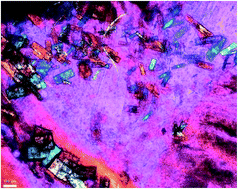In vitro and in vivo evaluation of benzathine foscarnet microcrystals as a potential intravitreal drug depot†
Abstract
Sodium foscarnet is an antiviral drug against cytomegalovirus retinitis, and clinically it is used via frequent intravitreal injection which causes various ocular complications. Here we propose to use benzathine foscarnet in a new salt form with much lower aqueous solubility, and as a potential long-acting intravitreally injectable solid form for foscarnet. Benzathine foscarnet (1 : 1) microcrystals were synthesized and evaluated both in vitro and in vivo. The aqueous solubility of benzathine foscarnet was 14.2 mM, which is in between those of the currently-used sodium foscarnet and our previously-reported calcium foscarnet salt. In a rabbit model, the injected microcrystals last for about 3 weeks in the vitreous, suggesting its solubility and dissolution profile is appropriate for its intended use. However, the injected benzathine foscarnet microcrystals also caused adverse effects in vivo.



 Please wait while we load your content...
Please wait while we load your content...